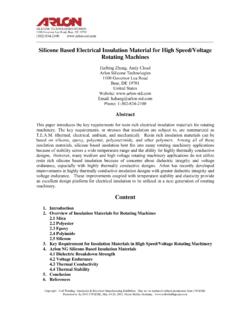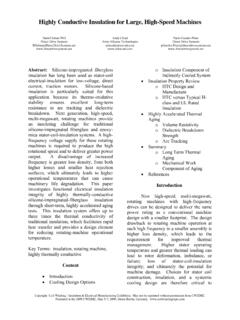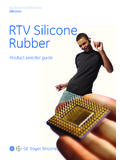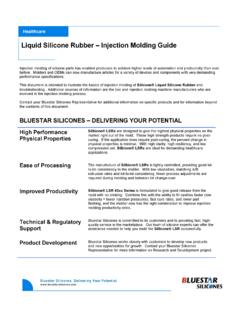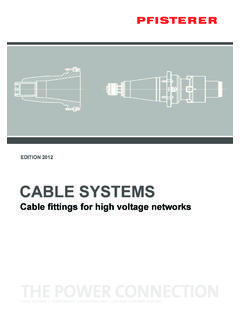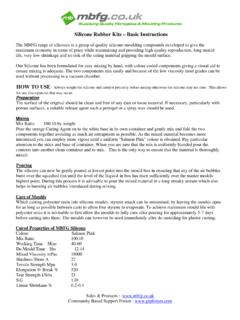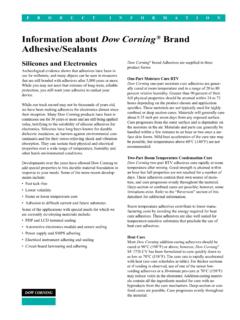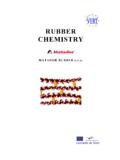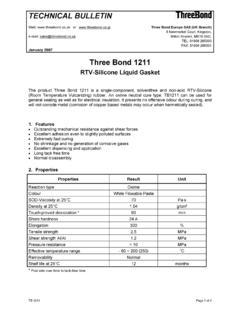Transcription of The Permeability Characteristics of Silicone Rubber
1 _____ Copyright 2006 by SAMPE Society for the Advancement of Material and Process Engineering. Reprinted with permission from the 2006 SAMPE Fall Technical Conference, Global Advances in Materials and Process Engineering , proceedings, Coatings and Sealants Section, November 6 9, 2006, Dallas, TX. ISBN 978-0-938994-72-5. The Permeability Characteristics of Silicone Rubber Haibing Zhang, Andy Cloud Arlon Silicone Technologies Division 1100 Governor Lea Road Bear, DE 19701 302-834-2100 ABSTRACT Silicone Rubber is universally regarded as the best-in-class elastomer for extreme environments.
2 In addition, Silicone Rubber is one of the most permeable elastomers. This property is a key advantage for Silicone Rubber in many design situations. However, some applications which require Silicone performance in extreme environments also require low gas Permeability . Applications that require such material Characteristics cover a range of aerospace components such as inflatables, ducting, and diaphragms. This paper presents a technical review of the gas Permeability Characteristics of Silicone Rubber , including analysis of the gas penetration mechanism through the elastomer.
3 The chemical structure of Silicone Rubber affects Permeability , as do other governing factors such as temperature and gas type. In particular, phenyl vinyl methyl Silicone (PVMQ) has the lowest glass transition temperature (-120 C) of all elastomers, but its gas Permeability is very high. Arlon has developed a proprietary technology to reduce the gas Permeability of PVMQ. Arlon s technological approach produces large gains in gas Permeability reduction without sacrificing excellent low temperature elastomeric flexibility. KEY WORDS: Silicone , Permeability , Low Temperature Flexibility 1.
4 INTRODUCTION The high flexibility of the silicon-oxygen chain in Silicone provides openings which are free volume and permit gas diffusion. The typical silicones such as vinyl methyl siloxane, (VMQ) and PVMQ, are two of the most permeable elastomers [1]. High Permeability of Silicone can be applied in membranes for blood oxygenation, gas separation, drug delivery, and fundamental studies to gain insight of the molecular structure of Silicone elastomer [1]. The penetration mechanism of gas in polymer can also be applied to Silicone Rubber to help understand gas Permeability .
5 Free volume or holes exists in the Rubber matrix. Holes thermally form and disappear with the movement of polymer chains. Gases are soluble in rubberlike substance. When Rubber is exposed to a gas, solution occurs at the surface and the dissolved gas molecules diffuse into the interior. The diffusion of gas molecules in the Rubber membrane is a process in which the gas molecules migrate from holes (free volume) to holes (free volume). The permeation of gas through a membrane involves in solution on one side, diffusion through the membrane to the other side, and finally evaporation out of membrane [2], as shown in Figure 1.
6 The rate of permeation is a specific function of a given gas and Rubber [3]. The rate of permeation depends on both solubility and the diffusion rate. _____ Copyright 2006 by SAMPE Society for the Advancement of Material and Process Engineering. Reprinted with permission from the 2006 SAMPE Fall Technical Conference, Global Advances in Materials and Process Engineering , proceedings, Coatings and Sealants Section, November 6 9, 2006, Dallas, TX. ISBN 978-0-938994-72-5. Figure 1 The schematic of gas permeation in a Rubber membrane The solution and evaporation phenomena conform to Henry s law [4]: c=S*p Equation (1) Where, c is the concentration of gas molecules in Rubber , S is the solubility of gas in Rubber , and p is the pressure of gas.
7 Diffusion theory is based on the hypothesis that the net rate of transfer of a diffusing substance through a unit sectional area of an isotropic material is proportional to the concentration gradient normal to the section. The diffusion conforms to Fick s first law (steady state) and Fick s second law (non steady state or time dependant). One dimension Fick s first law is described as: Equation (2) Where, F (flux) is the rate of transfer per unit area, c is the concentration of gas molecules at position x in the Rubber matrix, and D is the diffusion coefficient.
8 One dimensional Fick s second law (time-dependent diffusion equation) is described as: Equation (3) Where, t is time Rubber membrane Gas molecule Free volume Solution Diffusion Evaporation dxdcDF =22xcDtc = _____ Copyright 2006 by SAMPE Society for the Advancement of Material and Process Engineering. Reprinted with permission from the 2006 SAMPE Fall Technical Conference, Global Advances in Materials and Process Engineering , proceedings, Coatings and Sealants Section, November 6 9, 2006, Dallas, TX. ISBN 978-0-938994-72-5.
9 In most of applications, Permeability of a membrane is used to characterize the rate of permeation. Permeability is usually calculated by the following equation [2, 3, 5, 6, 7, 8], )(01pptAvP = Equation (4) Where, P is the Permeability for a given gas in a given membrane, v is the volume of gas which penetrates through the membrane, is the thickness of membrane, A is the area of membrane, t is time, p1 is the partial pressure of the gas on the higher pressure side of the membrane, and p0 is the partial pressure of the gas on the lower pressure side of the membrane.
10 In aerospace applications, where material weight is critical, is often replaced by the weight per unit area of membrane. )(01pptAwvP = Equation (5) Where, w is the weight of membrane per unit area 2. EXPERIMENTAL Materials PVMQ (phenyl vinyl methyl siloxane) in this study is SILASTIC LT-50 of Dow Corning. Loperm M-4342 is a type fluorosilicone Rubber of Dow Corning. The formulations in this study are mixed on the two-roll mill. Some special components are added into formulation to obtain Arlon modified PVMQ.
